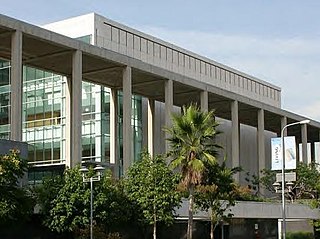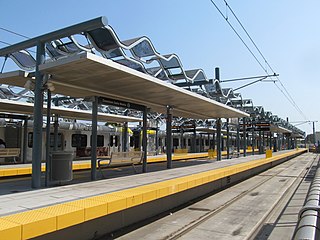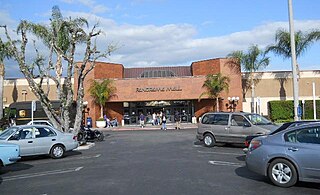
The Shrine Auditorium is a landmark large-event venue in Los Angeles, California. It is also the headquarters of the Al Malaikah Temple, a division of the Shriners. It was designated a Los Angeles Historic-Cultural Monument in 1975, and was added to the National Register of Historic Places in 1987.

The Los Angeles Music Center is one of the largest performing arts centers in the United States. Located in downtown Los Angeles, The Music Center is composed of the Dorothy Chandler Pavilion, Ahmanson Theatre, Mark Taper Forum, Roy & Edna Disney CalArts Theatre (REDCAT), and Walt Disney Concert Hall.

The Dorothy Chandler Pavilion is one of the halls in the Los Angeles Music Center, which is one of the largest performing arts centers in the United States. The Music Center's other halls include the Mark Taper Forum, Ahmanson Theatre, and Walt Disney Concert Hall.

Welton David Becket was an American modern architect who designed many buildings in Los Angeles, California.

The Grand Olympic Auditorium is a former sports venue in southern Downtown Los Angeles, California. The venue was built in 1924 at 1801 South Grand Avenue, now just south of the Santa Monica Freeway. The grand opening of the Olympic Auditorium was on August 5, 1925, and was a major media event, attended by such celebrities as Jack Dempsey and Rudolph Valentino. One of the last major boxing and wrestling arenas still in existence, the venue now serves as a worship space for the Korean-American evangelical church, "Glory Church of Jesus Christ".

Norfolk Scope is a multi-function complex in Norfolk, Virginia, comprising the 11,000-seat Scope Arena, a 2,500-seat theater known as Chrysler Hall, a 65,000-square-foot (6,000 m2) modular exhibition hall, and a 600-car parking garage.

The MassMutual Center is a multi-purpose arena and convention center complex located in downtown Springfield, Massachusetts, United States, in the city's Metro Center. The arena opened in 1972 and the convention center opened in 2005. It serves as a venue for meetings, conventions, exhibitions, sporting and entertainment events.

Duluth Entertainment Convention Center (DECC) is a multi-purpose arena and convention center complex located in Duluth, Minnesota. It has been home to the University of Minnesota Duluth Bulldog men's hockey team since 1966. The DECC is located on the waterfront near Duluth's famous Aerial Lift Bridge.

The Biltmore Fashion Park is an outdoor retail and dining mall located in the Biltmore District of Phoenix, Arizona, along East Camelback Rd. The Biltmore Fashion Park, as well as the surrounding business and residential district, is named after the historic Arizona Biltmore Hotel nearby.

The Mark Taper Forum is a 739-seat thrust stage at the Los Angeles Music Center designed by Welton Becket and Associates on the Bunker Hill section of Downtown Los Angeles. Named for real estate developer Mark Taper, the Forum, the neighboring Ahmanson Theatre and the Kirk Douglas Theatre are all operated by the Center Theatre Group.

The Pasadena Convention Center is a convention center in Pasadena, California, United States. It consists of three buildings.

Mobile Civic Center is a multi-purpose facility located in Mobile, Alabama. Owned by the City of Mobile and operated by ASM Global, the facility consists of three venues: a theater, an expo hall, and an arena. It is suitable for large indoor events including sporting events and trade shows. The theater seats for 1,938, while the expo hall can seat 3,000. The largest venue of the Mobile Civic Center is the arena, which can seat 10,112.

Public Auditorium is a multi-purpose performing arts, entertainment, sports, and exposition facility located in the civic center district of downtown Cleveland, Ohio. The 10,000-capacity main auditorium shares its stage with a second venue housed at the facility: the 3,000-capacity Music Hall. Although Public Auditorium was planned and funded prior to World War I, construction did not begin until 1920, and the building did not open until 1922. Designed by city architect J. Harold McDowell and Frank Walker of Walker and Weeks in a neoclassical style matching the other Group Plan buildings, it was the largest of its kind when opened, then seating 11,500.
Pico Boulevard is a major Los Angeles street that runs from the Pacific Ocean at Appian Way in Santa Monica to Central Avenue in Downtown Los Angeles, California, United States. It is named after Pío Pico, the last Mexican governor of Alta California.

Century II Performing Arts & Convention Center is a performing arts and convention center in Wichita, Kansas, United States. It is located between Douglas Street and Waterman Street near the east bank of the Arkansas River in downtown Wichita. It was listed on the National Register of Historic Places in 2020. The convention center is operated by Kansas native Phillip Anschutz's ASM Global.

The Colorado Convention Center (CCC) is a multi-purpose convention center located in Downtown Denver, Colorado. At 2,200,000 square feet it is currently the 12th largest convention center in the United States. It opened in June 1990; the first event being the NBA draft for the Denver Nuggets. The convention center was expanded in 2004 to include several meeting rooms, two ballrooms and an indoor amphitheater. Since opening, the center hosts an average of around 400 events per year. Centrally located in the city, it has become one of Denver's many landmarks due to its architecture and is adjacent to the Denver Performing Arts Complex and is just blocks away from the Colorado State Capitol, Auraria Campus and the 16th Street Mall. The CCC is directly served via light rail by RTD's Theatre District–Convention Center station.

The San Jose Civic is a former arena, currently operating as a theatre and concert venue, located in downtown San Jose, California. The venue is owned by the City of San Jose, is managed by Team San Jose and is booked by Nederlander Concerts. The auditorium seats 3,036 which can be expanded up to 3,326 in a general admission setting.

The Ahmanson Theatre is one of the four main venues that compose the Los Angeles Music Center.

Downtown Santa Monica station is an at-grade light rail station in the Los Angeles Metro Rail system. It is located near the intersection of 4th Street and Colorado Avenue in downtown Santa Monica, California. It is the E Line's western terminal station.

Panorama Mall is a mall in Panorama City, San Fernando Valley, Los Angeles, California. It is an enclosed mall anchored by two large discount stores, Walmart and Curacao, aimed primarily at a Hispanic customer base.





















